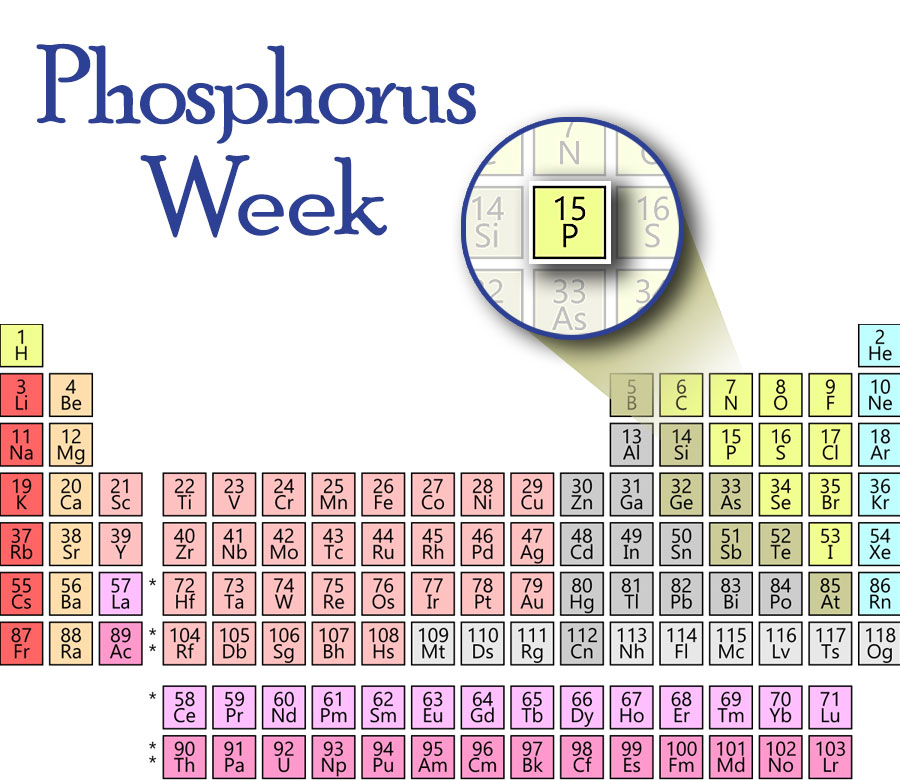Celebrating the 350th Anniversary of Phosphorus’ Discovery!
Did you ever wonder why your home and garden fertilizer has specific ratios of nutrients? Well, the story goes back even further – to the discovery of those elements! Phosphorus is one of the main “ingredients” for healthy plant growth. This year, 2019, is the 350th anniversary of the discovery of the element phosphorus, so the Soil Science Society of America (SSSA) and the American Society of Agronomy (ASA) are celebrating Phosphorus Week. We’ll have guest bloggers on Soils Matter this week, covering various topics. This first blog covers the discovery and general uses of phosphorus.
——
If you’ve taken high school chemistry, you’re familiar with the Periodic Table. It lists all the known elements. The Periodic Table categorizes elements based on various factors, like an element’s atomic number, characteristics about its electrons, and chemical properties.
 Before 1669, phosphorus was not a known element. It certainly was present in living matter, but determining what it was didn’t come easily. It was actually the first element discovered with “modern” scientific techniques!
Before 1669, phosphorus was not a known element. It certainly was present in living matter, but determining what it was didn’t come easily. It was actually the first element discovered with “modern” scientific techniques!
Phosphorus is the sixth most abundant element in living organisms (carbon is the first!) It is essential to life, and can be found in DNA and cell membranes. Phosphorus is that very important “P” in the ADP/ATP energy cycle.
Speaking of “P” – that became the chemical symbol for phosphorus. (Not all elements are named after their English-language equivalent…for example the symbol for sodium is Na from the chemical’s Latin name.)

“P” – in the form of “pee”, or urine, also happens to be the source of phosphorus’ discovery. It’s true: Hennig Brandt, the alchemist who discovered phosphorus, found the “P” in “pee.” (Also true, soil scientists do have their own special sense of humor!)
Brandt wasn’t searching for phosphorus though. Like many in his profession in the 1600s, he was searching for gold (chemical symbol Au). Of course, most urine is yellow, so it might make sense that it contains gold – but such is not the case. In fact, phosphorus and gold have nothing to do with each other – at least not chemically.
A fun fact about phosphorus is that it never occurs freely in nature. Because it is highly reactive, it binds with many other elements. Its typical chemical form in soil is a phosphate – chemical symbol PO4. This means that each phosphorus atom binds with four oxygen atoms. And, there is usually a positively charged element, like iron, aluminum, or calcium attached to a phosphate group.

Brandt discovered phosphorus due to another characteristic it has. In some forms, phosphorus can glow! This is called chemiluminescence.
Most phosphorus that we use today is mined from the earth. Researchers are looking for other ways to capture phosphorus as well, and that might include extraction from human waste (in a much more efficient manner than Brandt). It is used in agricultural fertilizers and a variety of household items. It’s also part of the fizz (and zing) in your soda!
Phosphorus is a necessary element for plant growth and good yields. Learning how to mine phosphorus, and apply it to farmers’ fields helped agriculture meet growing food demands. However, managing the phosphorus so that it’s used efficiently by plants is tricky. Research continues on the best ways to manage phosphorus in agriculture, how to continue to have sources of phosphorus, how to manage environmental factors associated with phosphorus, and phosphorus “stewardship.” Each of these topics is so important that we’ve invited others to write about them during Phosphorus Week.
Please read and share our other blogs about phosphorus, as ASA and SSSA celebrate the discovery of phosphorus!
By Andrew Sharpley, University of Arkansas
Read the other blogs in our phosphorus series!
Why is phosphorus needed on farms?
What are the sources of phosphorus for crops?
What are the challenges regarding phosphorus use?
Ten things we all can do to manage phosphorus better
To receive notices about future blogs, be sure to subscribe to Soils Matter by clicking on the Follow button on the upper right! Explore more on our webpage About Soils. There you will find more information about Soil Basics, Community Gardens, Green Infrastructure, Green Roofs, Soil Contaminants, materials for Teachers and more.

7 thoughts on “The discovery and general uses of phosphorus”